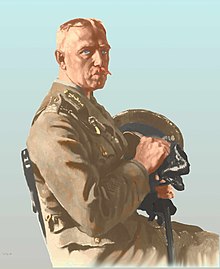Frederick Oscar Warren Loomis
Sir Frederick Loomis | |
|---|---|
 | |
| Born | February 1, 1870 Sherbrooke, Quebec |
| Died | February 15, 1937 (aged 67) Montreal, Quebec |
| Allegiance | |
| Service/ | Canadian Militia |
| Years of service | 1886-1919 |
| Rank | Major General |
| Commands held | 3rd Canadian Division |
| Battles/wars | First World War |
| Awards | Knight Commander of the Order of the Bath Companion of the Order of St Michael and St George Companion of the Distinguished Service Order |
Sir Frederick Oscar Warren Loomis KCB CMG DSO (February 1, 1870 – February 15, 1937) was a Canadian soldier who fought in the First World War.[1]
Military career[edit]
He enlisted as a private in the Canadian Militia in 1886 with the 53rd Sherbrooke Battalion of Infantry and was made a Provisional Lieutenant in 1897. He was commissioned a year later and transferred to 5th Regiment, Royal Highlanders of Canada in Montreal in 1903 and was later promoted to major in 1905.[1]
At the outbreak of war in August 1914 he enlisted for active service at the front and was given command of the 13th Battalion (Royal Highlanders of Canada), CEF. Promoted to rank of colonel in January 1916, he was given command of a training brigade in England. In May 1916, Loomis was promoted as a brigadier general and took command of the newly formed 7th Canadian Infantry Brigade. In July of that same year, he was appointed to command of the 2nd Canadian Infantry Brigade and would see the brigade through the battles at the Ypres Salient, Somme, Vimy Ridge, Arlleux, Hill 70, and Passchendaele during 1916 and 1917.[1] In 1918 he was engaged in battles at Amiens and Arras.[2] In September 1918, Loomis was promoted to major general and was given command of the 3rd Canadian Division and commanded the division during the last two months of the First World War, leading the division through the Battle of Cambrai and succeeding battles culminating in the capture of Mons on November 11, 1918.[1][2][3]
He was knighted by George V in 1919 for his service during the war and retired from the Canada Militia later in May of that year.[1] He was also highly decorated during the war, earning the Distinguished Service Order (DSO) in June 1915 and a bar to his DSO three years later, the citation for which reads:
For great gallantry and brilliant leadership during the operations south-east of Amiens, 8th/9th August, 1918, and east of Arras, 2nd September, 1918. He made reconnaissances under heavy fire, personally superintending the disposition of troops and encouraging all by his coolness and ability. The results achieved by the brigade were of an outstanding nature.[4]
Honours and legacy[edit]
On November 11, 2018, the hundredth anniversary of the Armistice with Germany, The Black Watch (Royal Highland Regiment) of Canada, with bagpipes and drums playing, marched through the streets of Mons to the building that was Major-General Frederick Loomis’s headquarters during the First World War. There a ceremony was held for the unveiling of a plaque commemorating this building as the HQ of the 3rd CDN Division.[5]
He is portrayed in a painting by Edgar Bundy on display in the Canadian Senate Chamber, leading the Royal Highlanders of Canada (Canadian Expeditionary Force) into Saint-Nazaire in 1915.
Mount Loomis on the Alberta–British Columbia border is named after him.[6]
References[edit]
- ^ a b c d e Parker, Charles Whately; Greene, Barnet M. (1912). Who's Who in Canada. p. 149. Retrieved 15 February 2016.
- ^ a b Nicholson, Gerald W. L. (1981). Canadian Expeditionary Force, 1914–1919: Official History of the Canadian Army in the First World War (PDF). QUEEN'S PRINTER. pp. 62, 67, 177, 453, 458, 542. Archived from the original (PDF) on 26 August 2011. Retrieved 14 June 2019.
- ^ 3rd Canadian Division page at canadiansoldiers.com
- ^ "No. 31680". The London Gazette (Supplement). 9 December 1919. p. 15283.
- ^ "Return to MONS". mons2018.blackwatchcanada. Retrieved 14 June 2019.
- ^ Boles, Glen W.; Putnam, William Lowell; Laurilla, Roger W. (2006). Canadian Mountain Place Names: The Rockies and Columbia Mountains. Rocky Mountain Books. p. 154. ISBN 9781894765794. Retrieved 15 February 2016.
See also[edit]
- Canadian Knights Commander of the Order of the Bath
- Canadian Companions of the Order of St Michael and St George
- Canadian Companions of the Distinguished Service Order
- 1870 births
- 1937 deaths
- Officers of the Legion of Honour
- Canadian military personnel from Quebec
- Bishop's College School alumni
- Businesspeople from Sherbrooke
- Canadian generals of World War I
- Canadian Expeditionary Force officers
- Canadian Militia officers
- 19th-century Canadian military personnel
- Canadian military personnel stubs
- Sherbrooke Hussars
- Black Watch (Royal Highland Regiment) of Canada officers
